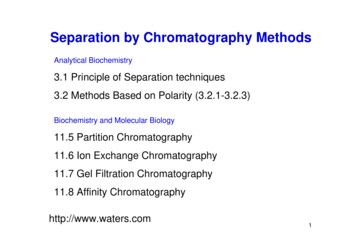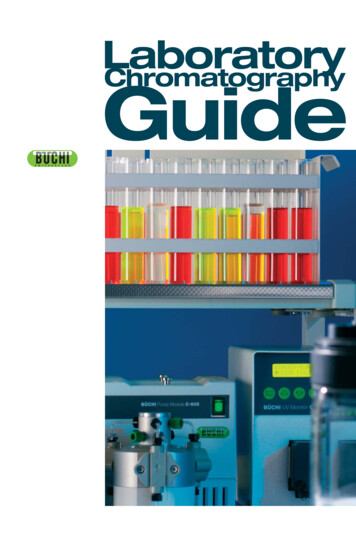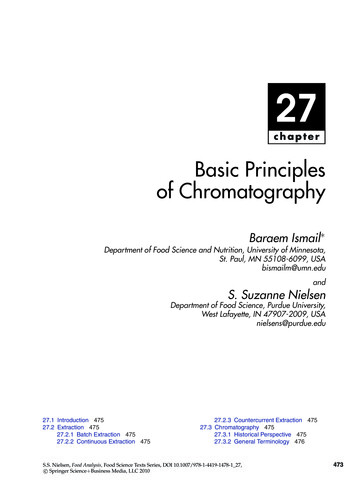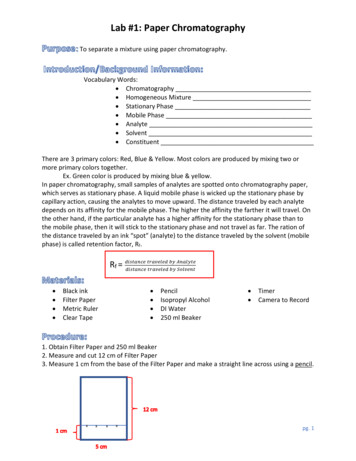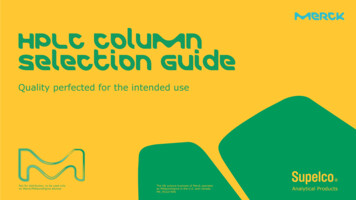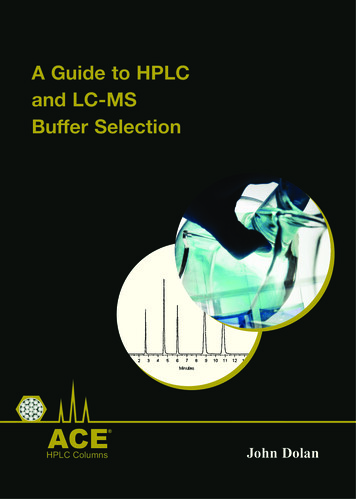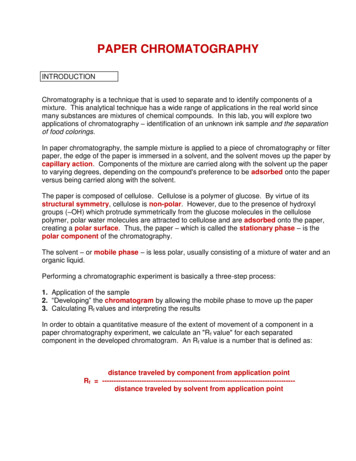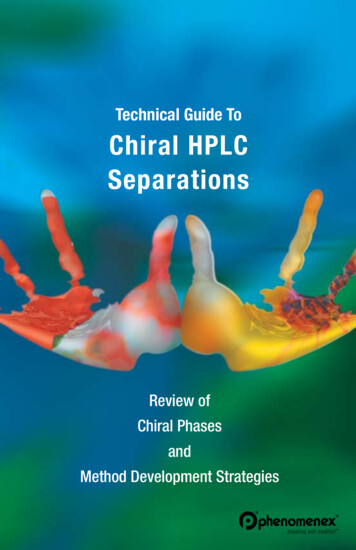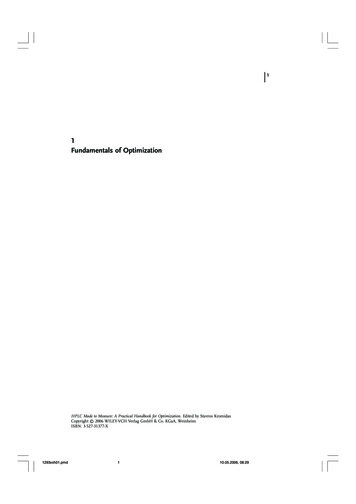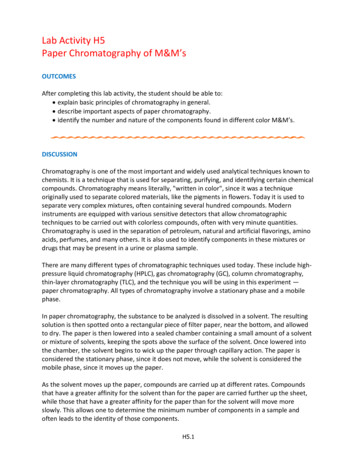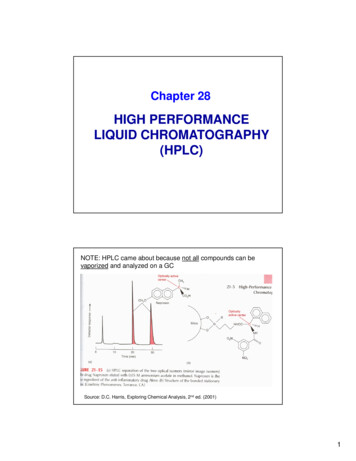
Transcription
Chapter 28HIGH PERFORMANCELIQUID CHROMATOGRAPHY(HPLC)NOTE: HPLC came about because not all compounds can bevaporized and analyzed on a GCSource: D.C. Harris, Exploring Chemical Analysis, 2nd ed. (2001)1
Summary of MethodHigh Performance Liquid Chromatography (HPLC) An analytical separation technique that involves the high-pressureflow of a liquid through a column that contains the stationary phase.Mobile phase: LiquidStationary phase: Can be a solid (LSC) or a liquid (LLC) A mixture of compounds injected at one end of the columnseparates as the compounds pass through. Separated compounds are detected electronically as theyelute at the other end of the column.Comparison with GCParameterGCHPLCBasis ofseparationInteraction of solutes with Interaction of solutesthe s.p.; solute vaporwith both the s.p. andpressurem.p.Analysis timeFast (a few minutes forsimple mixtures)Slower than GC(several minutes for asimple mixtureTemperature forseparationUsually requires a hightemperature ( 40 0C)Usually a roomtemperature techniqueSeparation of volatile andthermally stablecompounds - cannot beused for high MW andhighly polar compoundsSeparation of a widerrange of compounds -high MW, polar, andionic compoundsApplications2
InstrumentationInstrumentation (Cont.)Major components1) Solvent or mobile phase Usually a mixture of an organic solvent (Ex. methanol, IPA)and water Solvent polarity affects the separation process Sometimes buffered - keeps solutes in electrically neutral formMobile phase considerations Must be filtered (to prevent tiny solids from depositing at thecolumn head) and degassed Bubbles could interfere with detection Degassing is done by helium sparging3
Instrumentation (Cont.)2. Pump Role is to pump the solvent at a high pressure (usually from1000 to 6000 psi) through the packed columnInstrumentation (Cont.)3. Sample introduction system Introduces the injected sample to the flowing mobile phase Usually a loop injector – see image below Automated injectors are common4
Instrumentation (Cont.)4. Column A small metal tube (typically 5 to 30 cm long; 1-5 mm i.d.)that contains the stationary phase Role is to separate the components of a mixtureColumn – Cont. Much shorter than columns used in GC --- Why? Highly efficient separations achieved in HPLC due tointeractions of both m.p. and s.p. with the components ofa mixture No need for long columns vs. GC, where only the s.p. interacts withcomponents5
Instrumentation (Cont.)5. Detector Different design from those of GC detectors because thecomponents are dissolved in a liquid m.p. (vs. gas in GC)Detectors – Cont.UV detectors – most commonUV absorption cell for HPLC Applications: Respond tosubstances that absorb light inthe range 180 to 350 nm Z-shaped flow cell - moretime for UV light to pass th/ Most organics π systems (aromatics,alkenes, alkynes) Carbonyls6
Mass spectrometric detectors – in LCMS Challenges: (1) Converting liquid column effluent to gas(Recall: MS is a gaseous phase technique) and(2) removing a lot of solvent before entering MSElectrosprayionization* Use of nanoscale capillary LC – flow rates of µL/min* Similar to a nebulizer, but uses anelectrode and high voltage to form fine,charged dropletsHPLC Column SelectionDependent on the:(1) type of mixture being separated, and(2) type of interaction with the s.p.7
Two kinds of liquid chromatography based on the type ofmixture being separated1) Normal phase chromatography utilizes a: polar s.p. nonpolar m.p. Has its origin in older LSC, which utilized polar silica oralumina s.p. Uses normal phase columns Made of polar stationary phase bonded to a solid supportCalled bonded phase s.p.Application: Separation of polar compounds (amino acids andpeptides, alcohols, carboxylic acids)Examples of polar bonded (stationary) phases:Examples of nonpolar or low polarity mobile phases Hydrocarbons, such as hexane (C6H14) and toluene(C7H8) Chloroform, CHCl38
2) Reverse phase chromatography - utilizes a: nonpolar s.p. and polar m.p. Uses reverse phase columns contains nonpolar bondedphase s.p.Application: Separation of nonpolar compoundsOctyl C8Octadecyl C18Reverse phase chromatography (Cont.)Example of nonpolar bonded (stationary) phases: Hydrocarbons (with C8 and C18; most common)Example of polar mobile phases A mixture of water and an organic solvent (methanol,acetonitrile)Note: Bonded phases are usually attached to a silica or silica-basedsolid supportSilica w/ reactivesilanol (Si-OH) groupsReplacement of silanol group w/ Rgroups to produce bonded phases9
Selection of Mobile PhaseEluent strength ability of the m.p. to elute a solute from the column Increased by approaching the polarity of the s.p. (i.e. bycompeting w/ the s.p. for the solute) Results to better elution of components at a shorteranalysis timeQ. What changes can be done to increase the eluent strength in HPLC?Normal phase chromatography eluent strength by polarity of the m.p.In practice: Add a miscible, more polar solventReverse phase chromatography eluent strength by polarity of the m.p.In practice: Add a miscible, less polar solventIncreasing eluent strength (Cont.)Drill: Arrange the following solvents in the order ofincreasing polarity. Acetonitrile; hexane; water; methanol; isopropyl alcoholAnswer:Hexane Acetonitrile Isopropyl alcohol Methanol WaterIncreasing eluent strength (Cont.) Normal phase chromatography Increase proportion ofwater or methanol, or decrease amount of hexane (becomes more polar) Reverse phase chromatography Decrease proportion ofwater or methanol10
Effect of other parameters on retention of solutes1. Column length effect length, tR analysis time2. Polarity of the s.p. Polar solutes are more soluble (more retained)in polar s.p.3. Mobile phase flow ratem.p. flow rate, tR analysis timeEffect of other parameters Q. How would you decrease tR of strongly retained solutes? Increase m.p. flow rate, and/or Increase eluent strength, and/or Use a shorter column last resort4. Polarity of mobile phase Polar m.p. elutes polar components faster;Nonpolar m.p. elutes nonpolar components faster11
Increasingpolarity of m.p.Increasingpolarity ofm.p. As the polarity of the m.p. approaches that of the s.p.,tR decreases due to increased eluent strengthEffect of other parameters on retention of solutes (Cont.)5. Nature of bonded s.p. Retention increases as chain length increases12
Challenge: What kind of sampleswould contain these compounds?13
Solvent composition in HPLCISOCRATIC vs. GRADIENT ELUTION Analogous to isothermal vs. programmed temperature inGC in terms of outcomeIsocratic elution Uses a constant solvent composition throughout theseparation process Ideal for the separation of simple mixturesGradient elution Solvent composition is changed in time (by increasingeluent strength) Applies to the separation of more complex mixturesIsocratic vs. Gradient Elution of chlorinated benzenes on aC18 columnIsocratic elution Poor resolution of early-eluting solutes Extremely long tR of late-eluting solutesGradient elution Improved separation within amuch shorter timeSource: Skoog, Holler and Nieman, Principles ofInstrumental Analysis.” 5th ed., Harcourt Brace,1998.14
1. Column length effect Effect of other parameters on retention of solutes length, tR analysis time 2. Polarity of the s.p. Polar solutes are more soluble (more retained) in polar s.p. 3. Mobile phase flow rate m.p. flow rate, t R analysis time Increas
